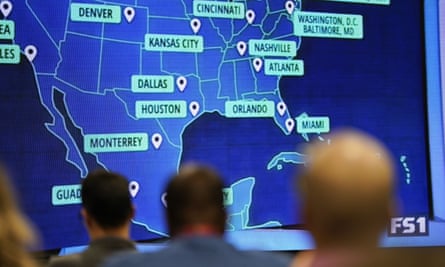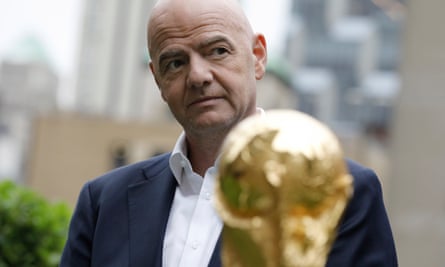
These, Gianni Infantino said earlier this week, have been the greatest group stages of all time. Unusually, he might be right (although his claim this was the most diverse last 16 is debatable at best). The football is only a small part of this World Cup but it has been largely excellent.
There have been some shocks, some favourites went home early, some played up to their pre-tournament billing and every group produced tension and intrigue. Infantino was conducting an in-house interview, hiding from journalists and accountability as he has since his bizarre address the day before the tournament began, which meant that nobody could ask the obvious question: if these group stages have been so good, why is he getting rid of them?

The 2026 World Cup in the USA, Mexico and Canada will have 48 teams. Initially, the plan had been for 16 groups of three with the top two going into a 32-team knockout, a terrible idea that invites collusion in the final group game, but Fifa has, thankfully, begun to reconsider.
The problem is that 48 teams is a bad number. It does not reduce easily to a power of two. Given eight groups of six would make the World Cup interminable, the likelihood is 12 groups of four, with the top two and eight best third-placed teams going through, a dismal compromise that leads inevitably to dead rubbers, doubly penalises teams in tough groups and advantages later groups whose potential third-place sides will know what they need to progress.
It is almost as if Infantino didn’t take the decision for footballing reasons, but to play to his power base in Africa, Asia and Central America, who will now be allocated an increased proportion of World Cup slots.
The number of slots each confederation is granted is a matter of understandable debate. Delegates for the Confederation of African Football (Caf), for instance, insist it is unfair they have five slots for 54 members while Uefa, with 55 members, has 13. To which the response is that at the past five World Cups, including this one, only six of 26 African entrants (23%) have made it through the group while 40 of 67 European teams (60%) have. Why dilute the quality with teams who make little impact?
You can get into all kinds of abstruse arguments about whether it is a benefit to have more than one team from a confederation in the same group, but the argument – at least from a football rather than a political point of view – essentially boils down to the same thing: finding the balance between spreading the game and making the World Cup a battle between the very best sides (for what it’s worth, if the World Cup was contested by the top 32 sides in the Fifa world rankings there would be 16 teams from Uefa and four from Caf).
The 48-team World Cup will, at least, give more opportunity to sides from outside the traditional elites. But there is a way of offering opportunity, providing a measure of fairness and development, while retaining the eight groups of four structure that works so well – and that is to globalise the final round of qualifying.
Quick Guide
Qatar: beyond the football
Show

This is a World Cup like no other. For the last 12 years the Guardian has been reporting on the issues surrounding Qatar 2022, from corruption and human rights abuses to the treatment of migrant workers and discriminatory laws. The best of our journalism is gathered on our dedicated Qatar: Beyond the Football home page for those who want to go deeper into the issues beyond the pitch.
Guardian reporting goes far beyond what happens on the pitch. Support our investigative journalism today.
For the sake of argument, imagine a pair of hosts. Then have regional pre-qualifying to get down to 80 nations: 30 from Uefa, 20 from the Americas (Conmebol and Concacaf considered as one to avoid the issue of there being 10 South American nations), 15 from Africa and 15 from Asia and Oceania.
They can then compete in 20 groups of four – 10 groups would have two Uefa nations – but otherwise teams from the same continent would be kept apart. Play home and away with the 20 top sides qualifying as of right and the 20 runners-up playing off for the 10 remaining places. Maybe you end up with 25 Uefa teams at the finals; or maybe you end up with only a handful. But the point is that a far greater spread of countries would have had a chance.
It would also mean three big home games for every side, offering fans in, say, Ghana or Honduras a far greater chance of seeing their country take on a Brazil or a France than if matches were being played on the other side of the world. Fifa may have to help fund infrastructure development in some places, but improving a stadium to international standards would be specific and direct development, which is surely better than the nebulous plans it often funds today.
Globalised qualifying also offers variety, so there wouldn’t be the same sense of fatigue of Wales playing Belgium or the Republic of Ireland playing Denmark twice a year – and that, presumably, would be attractive to sponsors, advertisers and broadcasters.

The only real argument against is the carbon footprint – and that is an undeniable problem. But it is a huge problem generally for football and one to which it has not really faced up. It is certainly not a bigger issue than 48 teams flying across the US, Mexico and Canada for six weeks in 2026.
Fully globalised qualifying won’t happen because football’s leaders are more concerned with entrenching their own positions and incomes than with what is actually good for the game. But if we did somehow enter a brave new world when football was placed front and centre in football administration, this is what a future World Cup might look like:
Imagine 2030 is staged by Spain and Portugal (although Ukraine is part of their bid, a return to 32 teams makes a third host nation unnecessary). They both qualify as of right. Taking the other 20 highest-ranked sides in the Fifa rankings, you end up with 11 European seeds, six from the Americas, two from Africa and one from Asia. Placing one of them in each pot, using the rankings to determine who qualifies from each continent, assuming Russia remain suspended and with a tweak to include New Zealand as an Oceanian representative, a qualifying draw might look like this:
A: Serbia, Austria, Canada, Ghana
B: Argentina, Slovenia, UAE, Gabon
C: Morocco, Iceland, El Salvador, Uzbekistan
D: USA, Finland, Syria, Ivory Coast
E: Uruguay, Norway, Jordan, Algeria
F: Croatia, Poland, Ecuador, South Africa
G: Wales, Czech Republic, Haiti, Nigeria
H: England, Turkey, Panama, Japan
I: Denmark, Bosnia-Herzegovina, Honduras, China
J: Italy, Hungary, Bolivia, Australia
K: Germany, Sweden, Curaçao, Iraq
L: Iran, Romania, Jamaica, Mali
M: Belgium, Costa Rica, New Zealand, DR Congo
N: Netherlands, Ukraine, Venezuela, Cape Verde
O: Colombia, Albania, Qatar, Cameroon
P: France, Slovakia, Peru, Oman
Q: Switzerland, Northern Ireland, Chile, Tunisia
R: Brazil, Greece, Bahrain, Egypt
S: Mexico, Republic of Ireland, South Korea, Burkina Faso
T: Senegal, Scotland, Paraguay, Saudi Arabia






